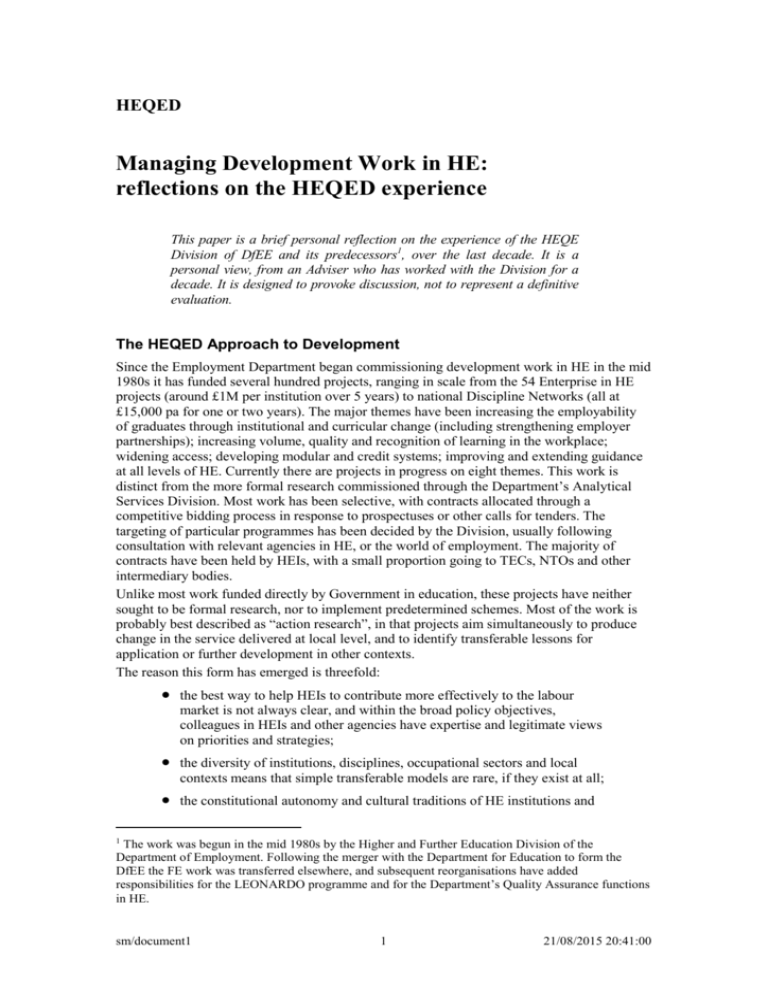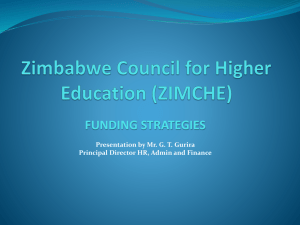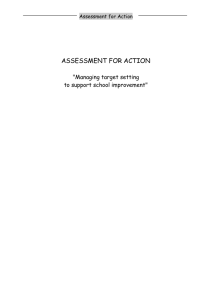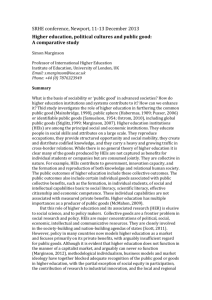Development in HE -a discussion paper
advertisement

HEQED Managing Development Work in HE: reflections on the HEQED experience This paper is a brief personal reflection on the experience of the HEQE Division of DfEE and its predecessors1, over the last decade. It is a personal view, from an Adviser who has worked with the Division for a decade. It is designed to provoke discussion, not to represent a definitive evaluation. The HEQED Approach to Development Since the Employment Department began commissioning development work in HE in the mid 1980s it has funded several hundred projects, ranging in scale from the 54 Enterprise in HE projects (around £1M per institution over 5 years) to national Discipline Networks (all at £15,000 pa for one or two years). The major themes have been increasing the employability of graduates through institutional and curricular change (including strengthening employer partnerships); increasing volume, quality and recognition of learning in the workplace; widening access; developing modular and credit systems; improving and extending guidance at all levels of HE. Currently there are projects in progress on eight themes. This work is distinct from the more formal research commissioned through the Department’s Analytical Services Division. Most work has been selective, with contracts allocated through a competitive bidding process in response to prospectuses or other calls for tenders. The targeting of particular programmes has been decided by the Division, usually following consultation with relevant agencies in HE, or the world of employment. The majority of contracts have been held by HEIs, with a small proportion going to TECs, NTOs and other intermediary bodies. Unlike most work funded directly by Government in education, these projects have neither sought to be formal research, nor to implement predetermined schemes. Most of the work is probably best described as “action research”, in that projects aim simultaneously to produce change in the service delivered at local level, and to identify transferable lessons for application or further development in other contexts. The reason this form has emerged is threefold: the best way to help HEIs to contribute more effectively to the labour market is not always clear, and within the broad policy objectives, colleagues in HEIs and other agencies have expertise and legitimate views on priorities and strategies; the diversity of institutions, disciplines, occupational sectors and local contexts means that simple transferable models are rare, if they exist at all; the constitutional autonomy and cultural traditions of HE institutions and 1 The work was begun in the mid 1980s by the Higher and Further Education Division of the Department of Employment. Following the merger with the Department for Education to form the DfEE the FE work was transferred elsewhere, and subsequent reorganisations have added responsibilities for the LEONARDO programme and for the Department’s Quality Assurance functions in HE. sm/document1 1 21/08/2015 20:41:00 their staff mean that the DfEE cannot insist on particular action by HE institutions: and only development undertaken on a partnership basis is likely to be “owned” and embedded in the long term.. Strengths At its best, this approach has built creative partnerships which have: produced curricular and structural changes in HEIs which have made graduates more employable and raised the skill and knowledge levels of existing employees supported parallel developments like the RoA, Profiling, developments in quality and assessment practice in HE. avoided the kind of “tokenism” experienced in some other areas of Government funding. The partnership approach, handled generally with considerable flexibility and sensitivity by the Department’s contract managers and advisers (themselves normally recruited from the world of HE), means that project staff have rarely been engaged simply in formal meeting of targets to acquire funding. increased knowledge of how change can be facilitated in HE, and of how HE can relate to the labour market The process has been assisted by the availability of specific, earmarked funding for specific purposes. Although the sums are relatively small, they cannot be top sliced, nor diverted by the institution. Weaknesses There have, however, sometimes been weaknesses. They include: lack of connection between academic expertise and development work within institutions lack of dissemination and retention of lessons learned rapid turnover of development staff - losing the acquired expertise failure to connect development work to broader institutional strategic development lack of intellectual rigour in the management and evaluation of the work Penetration and Impact Over a decade, almost all HE institutions in England have participated in one or more of the Division’s programmes, and a very large number of HE staff, ranging from temporary researchers and administrators to Heads of School and PVCs have taken part. However, some institutions have been much more heavily involved than others. It is difficult to assess the impact of this work with any precision, because it often seeks to produce subtle cultural change, which manifests itself in the practice of individual academics - an area where no data is routinely collected, and little is collected in any form. Furthermore, there are complex interactions between the DfEE work and that of other agencies seeking to promote change in related areas. Impressionistic assessments however, suggest that there have been changes in culture, organisation and practices within the system consistent with the Department’s broad long term agenda. sm/document1 2 21/08/2015 20:41:00 Institutional Management Despite this, there is an ongoing concern that the impact of the work is not as widespread as might be hoped, partly as a result of underinvestment in dissemination (an issue currently under review), and partly because of issues to do with institutional capacity to manage and embed development work. Institutional capacity to manage development and change is a major issue for the HE system as a whole, and the experience of the HEQED work suggests that there are a number of areas where improvements might be made. The following are some personal observations of shortcomings of many institutions in engaging with the DfEE’s agenda. Not all observers would necessarily agree, and not all apply to a majority of institutions, but all point to a need to review how institutions might be helped to engage more effectively in development work. Some of the lessons probably also have implications for other areas of the work of HEIs, where much work is, in practice, organised in a “project like” way. Bidding most HEQED work is commissioned through competitive bidding. Some institutions and individuals are evidently more skilled at writing bids (which does not always correlate with competence at undertaking the work). Many bids are stronger on rationale than methodology, and fail to present clear and achievable outcomes. Strategic links some institutions are poor at linking development project work to institutional strategy, especially when a piece of work is conceived as a “project”. Sometimes this reflects the institutional culture embedding key skills in the curriculum for all undergraduates is extremely difficult in a highly devolved institution, where more people have the power to prevent innovation than to progress it. Local and national the rationale for the HEQED investing money in a small number of institutions is that lessons will be learned for wider application. The Division is therefore interested in the relationship between project findings and the national policy agenda. Project staff sometimes have difficulty in seeing the bigger picture, and recognising the need to identify transferable lessons. Project steering normally a project steering committee is constituted to manage a project. Often such committees include a substantial number of nonacademics. Institutions are not always good at managing such groups, to ensure that all members have a clear role, and the ability to use their particular talents to the full. Partnership projects and institutions, especially those new to working with the Division, sometimes take time to develop an effective working relationship with HEQED. Most commonly they are surprised at the extent of the Division’s interest in the content (as distinct from the contract), and its willingness to debate and negotiate around ways of tackling the objectives Staffing institutions often recruit temporary staff to take on the major burden of project work. Such staff often start at a disadvantage in terms of knowledge of formal and informal structures, and credibility. They work best when they have access to powerful patrons. Knowledge retention It is common for much of the knowledge acquired through the project to reside with the individual project worker/s. The pressures of individual careers mean that such individuals often leave when the project ends (and often before). As a result, the “institutional learning” may be very much less than it appears. Evaluation in the past, evaluation has been a weak point in much of the work. Formal evaluations have been commissioned, but their findings sm/document1 3 21/08/2015 20:41:00 have often not influenced future development. Individual project staff have often regarded evaluation as something “done to” them, rather than a process in which they are engaged. The Division has distilled some of its experience into an Evaluation Guide which is now distributed to all new projects, but project staff still sometimes have difficulty in engaging with the process. Stephen McNair HE Adviser HEQED November 1998 sm/document1 4 21/08/2015 20:41:00












